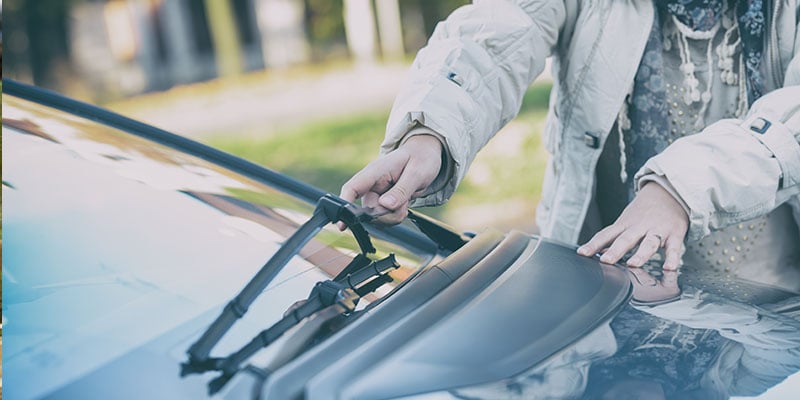
The weather is warming up and the days are getting longer. It’s time to leave the cold winter months behind and welcome spring. What should you know about car maintenance before you enjoy the warmer weather?
With its extreme temperatures and snowy, icy roads, winter can be tough on your vehicle. Learn the type of car care needed to help you transition into spring. Here are some car maintenance tips to help get you started:
Did you change your tires over for winter driving? Each state has its own regulations, but most require that you remove your studded tires by March or April at the latest. Check this guide provided by AAA and The Digest of Motor Laws for your state’s regulations.
This is also a good time to check your tread and air pressure. The usual recommended tire pressure is 32 PSI (pounds per square inch) and may vary between manufacturer’s car maintenance guides. The recommended PSI can usually be found in your owner's manual or on a sticker inside the driver’s door.
Tire pressure will fluctuate as the seasons change (roughly one psi every 10 degrees) so it’s important to adjust your pressure as the weather warms up. Maintaining proper tire pressure is an easy car care tip to extend the life of your tires and keep you safer on the road.
Heavily worn tire tread can lead to unsafe driving conditions. Here’s a brief video by Bridgestone showing a quick and simple way to check your tire tread using a penny. Remember to also have your tires rotated and balanced as part of your regular car maintenance routine.
Maintaining wheel alignment helps you enjoy a smooth and safe ride. Proper alignment also preserves the life of your tires and helps you avoid unnecessary car repairs. Rough winter roads and potholes can jolt your car out of alignment.
If you feel your car pulling to one side or failing to drive straight when your wheel is facing forward, your alignment may be off.
Good brakes are one of your first lines of defense and should be considered a priority in your car care schedule. Your brakes have been working overtime keeping you safe this winter as you navigate icy and salty roads. However, salt buildup can cause corrosion and damage to your brakes.
How do you know when it may be time to replace them? Beware of the“brake warning” light on your dash and don’t drive if you see this. Not all cars are equipped with this warning, so it’s important to listen to the sound of your brakes. Your brakes can be tested during routine car maintenance appointments.
The life of brakes (and brake pads) varies from driver to driver. Another factor is if you travel on urban roads (requiring more stops) or rural roads. Some signs of brake wear and tear include squeaking and squealing sounds. If you hear metal on metal grinding, this requires immediate attention from a qualified mechanic.

Snow and brutal winter weather can result in excess wear and tear on your car’s windshield wipers. Do your wipers streak, smear or skip? It may be time to replace them.
Auto manufacturers recommend changing both front and rear wipers every six months, or if your visibility becomes impaired. Check your car maintenance guide for specific instructions.
Another way of knowing when to replace windshield wipers is to inspect them. Are they cracked, flaky, split or excessively dry? Is the rubber separating from the metal arm? Is the arm bent or cracked?
Getting new wiper blades can be similar to needing new glasses. You don’t realize how much better you see until you replace them.
Along with spring comes more rain. You may opt to apply a protective coating to your windshield as part of your car maintenance. This will help repel water and rain. Also, check your windshield wiper fluid and top off as needed.
Spring is a great time to review your car insurance policy and claim any new discounts you may qualify for. Has a ticket recently been removed from your driving record? This can reduce your premium, so be sure it’s documented and updated.
If your credit score has increased since the date you applied for your car insurance policy, this could potentially lower your rate. Other things such as completing a driver’s education course or installing anti-theft devices can reduce your car insurance costs as well.
Have you paid off your car and now have a lienholder free-title? This releases you from certain mandatory coverages such as collision and comprehensive and can save you money if you opt to remove them. If your car is aging (and losing value), it may make sense to lower some of your car insurance coverage amounts.
Just as your home needs a spring cleaning, your car deserves one, too! It’s important to keep your car clean as part of your regular car maintenance routine. But in spring, your car deserves a little extra TLCC (tender loving car care).
Road salt and other dirt has been accumulating underneath your car and can cause rusting to occur. Drive through a deluxe car wash that sprays under your vehicle. Remove all of your mats and hose them down, vacuum thoroughly and clean out garbage. Wipe down your dash and inside the door jambs. Here are some other great tips for spring cleaning your car.
We hope you have enjoyed reading these tips about car maintenance for spring. Now get out there and soak up some nice weather!
Need to get a new insurance policy fast? We can give you a quote in just minutes! Get what you need to get back on the road today. Get a quote now!


Irvine, California
PO Box 7820
Newport Beach, CA 92658
Call us: 1-888-964-8556
No Comments Yet
Let us know what you think